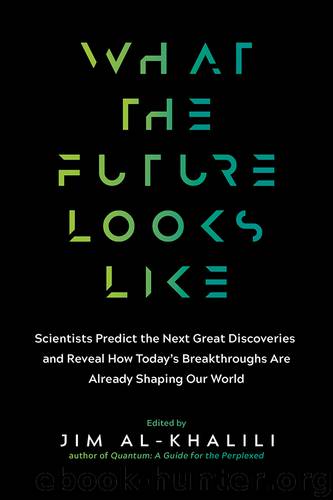What the Future Looks Like: Scientists Predict the Next Great Discoveries and Reveal How Today's Breakthroughs Are already Shaping the World by Jim Al-Khalili

Author:Jim Al-Khalili
Language: eng
Format: epub
Publisher: The Experiment
Published: 2018-01-01T02:00:00+00:00
10
Artificial intelligence
Margaret A. Boden
It’s impossible to say just where artificial intelligence (AI) will be in the future. But it’s easy to say where it won’t be: It won’t be hiding under a stone. Instead, it will be ubiquitous and inescapable.
AI is already active in many aspects of society. It’s at the heart of every internet search and every app. It’s in every GPS query, every video game and Hollywood animation, every bank and insurance company and hospital—and, of course, every smart watch and driverless car.
In the future, it will be found everywhere: law courts, offices, old people’s homes … even marriage guidance counseling. Mars robots will have countless cousins working on warehouse floors. The Inter net of Things will interconnect wearable computers (monitoring our location, activity levels, and blood pressure) with a host of gadgets in our homes, offices, streets, and restaurants. It won’t be Big Brother watching you, but rather trillions of little brothers—and all talking to each other nonstop.
These developments will happen quite soon—in fact, most have already started. Within a couple of decades, countless such examples will be shaping our lives. Industrial societies will be deeply dependent on them. And developing countries will be affected, too, as AI-based medical or agricultural advice (for instance) is made available to people living miles away from modern hospitals or agri-scientists.
One recent advance that has made all this possible is machine learning using Big Data—huge caches of information that can be analyzed for patterns and trends in human behavior. This AI technology—known as “deep learning”—has been known about in theory for over a quarter of a century but couldn’t be put into practice because computers weren’t sufficiently powerful. Over the past few years, how ever, computer power, and computer storage, have increased enough to enable today’s machines (doing a million billion calculations per second) to learn from enormous data-banks holding billions of items.
This type of machine learning can find patterns, on various levels of detail, in huge collections of data. These include (for instance) the current speed and location of every car and bus on a city’s roads, with the current state of every traffic light; or the medical records from every regional or national hospital, detailing every patient’s symptoms, drug dosages, and results.
Such AI systems aren’t programmed in the traditional sense of “do this, then do that.” Instead, they consist of multilayer neural networks, the output of one layer being fed in as input to the next. Each layer contains many thousands of units that communicate with each other until they “settle” into a state representing a stable pattern found in the data. Often, these patterns are new and unexpected—even unsuspected by the humans running the systems.
In 2016, an application of this technology (developed by Google DeepMind) learned to play the game Go well enough to beat the world champion—a feat much harder than beating the world chess champion (done by IBM’s Deep Blue in 1997). But while this was just a game, impressive as a demonstration, it was of no practical use.
Download
This site does not store any files on its server. We only index and link to content provided by other sites. Please contact the content providers to delete copyright contents if any and email us, we'll remove relevant links or contents immediately.
Enlightenment Now: The Case for Reason, Science, Humanism, and Progress by Steven Pinker(7272)
A Journey Through Charms and Defence Against the Dark Arts (Harry Potter: A Journey Through…) by Pottermore Publishing(4789)
The Immortal Life of Henrietta Lacks by Rebecca Skloot(4550)
A Journey Through Divination and Astronomy by Publishing Pottermore(4363)
Elon Musk by Ashlee Vance(4084)
Origin Story: A Big History of Everything by David Christian(3666)
COSMOS by Carl Sagan(3588)
Alchemy and Alchemists by C. J. S. Thompson(3481)
Bad Pharma by Ben Goldacre(3396)
Enlightenment Now by Steven Pinker(3349)
Shadow of Night by Deborah Harkness(3326)
Inferior by Angela Saini(3293)
A Mind For Numbers: How to Excel at Math and Science (Even If You Flunked Algebra) by Barbara Oakley(3256)
Origin Story by David Christian(3170)
The Code Book by Simon Singh(3138)
Signature in the Cell: DNA and the Evidence for Intelligent Design by Stephen C. Meyer(3098)
The Elements by Theodore Gray(3026)
A Brief History of Time by Stephen Hawking(2992)
A Journey Through Potions and Herbology (A Journey Through…) by Pottermore Publishing(2837)
